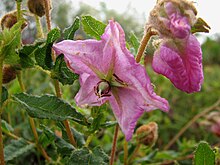Thomasia grandiflora
| Thomasia grandiflora | |
|---|---|

| |
| Scientific classification | |
| Kingdom: | Plantae |
| Clade: | Tracheophytes |
| Clade: | Angiosperms |
| Clade: | Eudicots |
| Clade: | Rosids |
| Order: | Malvales |
| Family: | Malvaceae |
| Genus: | Thomasia |
| Species: | T. grandiflora
|
| Binomial name | |
| Thomasia grandiflora | |
Thomasia grandiflora, commonly known as large-flowered thomasia,[2] is endemic to the south-west of Western Australia. The flowers are pinkish-purple with a papery appearance hanging in pendents from the leaf axils. The calyx lobes are prominent and larger than the petals.
Description[edit]
Thomasia grandiflora is a small shrub that grows to about 1 m (3 ft 3 in) high and wide. The dark, bright green leaves vary in shape, usually heart-shaped or occasionally narrowly elliptic, slightly flexible, leathery and 15–25 mm (0.59–0.98 in) long. The flowers have wide, conspicuous, pinkish-purple calyx lobes that are more prominent than the petals. The calyx is thicker near the mid-vein. The small petals are densely covered with star-shaped hairs, occasionally with only a few scattered hairs. The flowers have a papery texture and about 2 cm (0.79 in) across on short pendant stalks. The flowers are followed by capsules containing black seeds that are shed from the plant when ripe. Flowering occurs from winter to spring.[3][4][5]
Taxonomy and naming[edit]
Thomasia grandiflora was first formally described by botanist John Lindley in 1839 who published the description in A sketch of the vegetation of the Swan River Colony in 1839.[6][7] The specific epithet (grandiflora) is from the Latin grandis meaning "large" or "great"[8]: 378 and flos meaning "flower"[8]: 338 referring to the large flowers of the species.[5]
Distribution and habitat[edit]
Large-flowered thomasia is a widespread species, mostly found in near-coastal locations growing in open forest in the south-west of Western Australia.[5]
References[edit]
- ^ "Thomasia grandiflora". Australian Plant Census. Retrieved 15 September 2019.
- ^ Greig, Denise (1999). Field Guide to Australian Wildflowers. Avery Chase-New Holland. ISBN 1-86436-334-7.
- ^ "Thomasia grandiflora". FloraBase. Western Australian Government Department of Biodiversity, Conservation and Attractions.
- ^ Shepherd, Kelly A. (2019). "Thomasia grandiflora". Nuytsia (30). Retrieved 15 September 2019.
- ^ a b c Harris, Thistle Y. (1979). Gardening with Australian Plants. Melbourne, Victoria: Thomas Nelson Australia. ISBN 0-17-005120-X.
- ^ "Thomasia grandifolia". Australian Plant Name Index (APNI), IBIS database. Centre for Plant Biodiversity Research, Australian Government, Canberra. Retrieved 27 February 2009.
- ^ Lyndley, John. "A Sketch of the Vegetation of the Swan River Colony". Retrieved 15 September 2019.
- ^ a b Brown, Roland W. (1956). The Composition of Scientific Words. Washington D.C: Smithsonian Institution Press.
